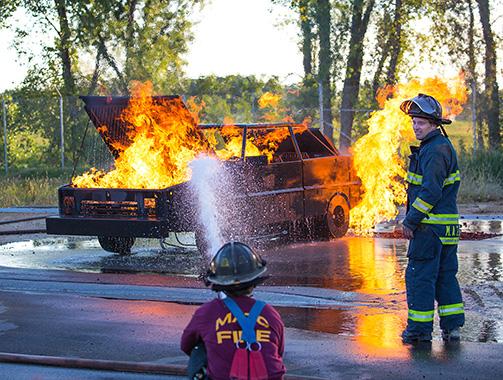Grand opening celebrates new fire training facilities

Two firefighters demonstrate how to put out a car fire during the opening of the new fire training facilities on Sept. 9.
September 15, 2015
The newly reconstructed Human and Protective services training facilities celebrated its grand opening on Sept. 9. The new burn tower and outdoor fire training center is located across the street from the college’s Protective Services Center at 1701 Pearson St.
Shawna Carter, Dean of the School of Human and Protective Services, welcomed guests and introduced speakers, which included City of Madison Fire Chief and Madison College Fire Service Chairman Steven Davis, Baraboo Fire Chief Kevin Stieve and District Board of Trustees member Frances Huntley-Cooper.
“Two things,” declared an emotional Davis after taking to the podium. “First, is that it’s about time.”
Construction of the new, high-tech facilities have been underway for nearly two years, the result of nearly a decade of strategic planning and negotiations between Madison College officials, the Madison fire department and Mayor Paul Soglin.
“The second is that this latest investment upholds a major element of our mission, which is to build healthier communities,” Davis added.
Addressing the audience and fighting back tears, Davis spoke of how the previous facilities came to be. According to Davis, there’s a legend that late and former Columbus Fire Chief James Boness sat down in the college president’s office one day, and refused to leave until he was promised a fire safety training facility on campus.
Included in the audience were some surviving family members and friends of Boness, who joined Davis in laughter as he recounted the story. Boness’s stubbornness paid off, leading to the construction of what was then a state of the art facility more than 20 years ago.
The centerpiece of the new facility is the simulated four-story commercial building and two-story residential building. Both can be filled with various levels of smoke and fire to give trainees the experience of a real emergency.
Surrounding them is an assortment of 17 training props, many of which are capable of spewing out large flames.
Closest to the gated entrance of the facility are four cars on a concrete slab, all in various states of destruction. They appear to have been damaged in collisions and rollovers, with glass and fluids spilling out from their interiors, like a macabre art installation.
A short distance away is a large garbage dumpster, as well as a propane tank like those responders might encounter at rural residences or commercial sites. There’s also a replica of a four-door sedan made entirely of metal, wheels and seats included.
These props are fed with propane from two large tanks that sit nearby. Within the props, the gas is ignited and blasted out from nozzles in various locations, providing trainees with the experience of having to handle real flames and hot surfaces, not too different from what they’re going to experience in a real fire emergency.
Safety is the first priority, however, so all fire-enabled props are equipped with safety features to ensure the trainees and instructors are never truly in harm’s way. And, during all fire training exercises a “fire bug” stands at the controls, ready to shut off the gas should anything go awry.
All told, the new $2.35 million facility will train future firefighters and other emergency responders from 80 different departments.






























